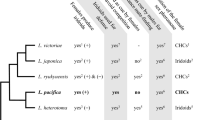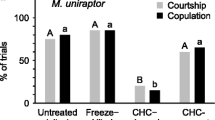Abstract
Deciphering the processes driving the evolution of the diverse pheromone-mediated chemical communication system of insects is a fascinating and challenging task. Understanding how pheromones have arisen has been supported by studies with the model organism Leptopilina heterotoma, a parasitoid wasp whose defensive compound (−)-iridomyrmecin also evolved as a component of the female sex pheromone and as a cue to avoid competition with other females during host search. To understand how compounds can evolve from being non-communicative to having a communicative function and to shed light on the evolution of the multi-functional use of iridomyrmecin in the genus Leptopilina, the chemical communication of two additional species, L. ryukyuensis and L. japonica, was studied. We demonstrate that in both species a species-specific mixture of iridoids is produced and emitted by wasps upon being attacked, consistent with their putative role as defensive compounds. In L. ryukyuensis these iridoids are also used by females to avoid host patches already exploited by other conspecific females. However, females of L. japonica do not avoid the odor of conspecific females during host search. We also show that the sex pheromone of female L. ryukyuensis consists of cuticular hydrocarbons (CHCs), as males showed strong courtship behavior (wing fanning) towards these compounds, but not towards the iridoid compounds. In contrast, males of L. japonica prefer their females’ iridoids but CHCs also elicit some courtship behavior. The use of iridoid compounds as defensive allomones seems to be common in the genus Leptopilina, while their communicative functions appear to have evolved in a species-specific manner.





Similar content being viewed by others
References
Benjamini Y, Hochberg Y (1995) Controlling the false discovery rate: a practical and powerful approach to multiple testing. J Roy Stat Soc B 57:289–300
Blum MS (1996) Semiochemical parsimony in the Arthropoda. Annu Rev Entomol 41:353–374. https://doi.org/10.1146/annurev.en.41.010196.002033
Boppré M (1986) Insects pharmacophagously utilizing defensive plant chemicals (pyrrolizidine alkaloids). Naturwissenschaften 73:17–26. https://doi.org/10.1007/BF01168801
Bradbury JW, Vehrencamp SL (2011) Principles of Animal Communication. Sinauer Associates, Sunderland
Carlson DA, Roan CS, Yost RA, Hector J (1989) Dimethyl disulfide derivatives of long chain alkenes, alkadienes, and alkatrienes for gas chromatography/mass spectrometry. Anal Chem 61:1564–1571. https://doi.org/10.1021/ac00189a019
Carlson DA, Bernier UR, Sutton BD (1998) Elution patterns from capillary GC for methyl-branched alkanes. J Chem Ecol 24:1845–1865. https://doi.org/10.1023/A:1022311701355
Carton Y, Boulétreau M, van Alphen JJM, van Lenteren JC (1986) The Drosophila parasitic wasps. In: Ashburner M, Carson HL, Thompson JN (eds) The Genetics and Biology of Drosophila. Academic Press, Orlando, pp 347–394
Do Nascimento RR, Billen J, Sant'ana AEG, Morgan ED, Harada AY (1998) Pygidial gland of Azteca NR. bicolor and Azteca chartifex: morphology and chemical identification of volatile components. J Chem Ecol 24:1629–1637. https://doi.org/10.1023/A:1020864427854
El-Sayed AM (2018) The Pherobase: Database of Pheromones and Semiochemicals. www.pherobase.com. Accessed 16 Jan 2018
Fleury F, Gibert P, Ris N, Allemand R (2009) Ecology and life history evolution of frugivorous Drosophila parasitoids. In: Prevost G (ed) Parasitoids of Drosophila. Academic Press, London, pp 3–44
Geiselhardt S, Jakobschy D, Ockenfels P, Peschke K (2008) A sex pheromone in the desert tenebrionid beetle Parastizopus armaticeps. J Chem Ecol 34:1065–1071. https://doi.org/10.1007/s10886-008-9488-1
Gibbs AG, Rajpurohit S (2010) Cuticular lipids and water balance. In: Bagnères A-G, Blomquist GJ (eds) Insect Hydrocarbons. Biology, Biochemistry, and Chemical Ecology. Cambridge University Press, Cambridge, pp 100–120
Greenspan RJ, Ferveur J-F (2000) Courtship in Drosophila. Annu Rev Genet 34:205–232
Hübner G, Dettner K (2000) Hyperparasitoid defense strategies against spiders: the role of chemical and morphological protection. Entomol Exp Appl 97:67–74. https://doi.org/10.1046/j.1570-7458.2000.00717.x
Hübner G, Völkl W, Francke W, Dettner K (2002) Mandibular gland secretions in alloxystine wasps (Hymenoptera, Cynipoidea, Charipidae): do ecological or phylogenetical constraints influence occurrence or composition? Biochem Syst Ecol 30:505–523. https://doi.org/10.1016/S0305-1978(01)00137-5
Huth A, Dettner K (1990) Defense chemicals from abdominal glands of 13 rove beetle species of subtribe Staphylinina (Coleoptera: Staphylinidae, Staphylininae). J Chem Ecol 16:2691–2711. https://doi.org/10.1007/BF00988079
Isidoro N, Bin F, Romani R, Pujade-Villar J, Ros-Farre P (1999) Diversity and function of male antennal glands in Cynipoidea (Hymenoptera). Zool Scr 28:165–174. https://doi.org/10.1046/j.1463-6409.1999.00013.x
Karlson P, Lüscher M (1959) Pheromone. Naturwissenschaften 46:63–64. https://doi.org/10.1007/BF00599084
Kühbandner S, Sperling S, Mori K, Ruther J (2012) Deciphering the signature of cuticular lipids with contact sex pheromone function in a parasitic wasp. J Exp Biol 215:2471–2478. https://doi.org/10.1242/jeb.071217
Lockey LH (1988) Lipids of the insect cuticle: origin, composition and function. Comp Biochem Physiol B 89:595–645
Löfqvist J (1976) Formic acid and saturated hydrocarbons as alarm pheromones for the ant Formica rufa. J Insect Physiol 22:1331–1346. https://doi.org/10.1016/0022-1910(76)90155-4
Mori K, Shikichi Y, Shankar S, Yew JY (2010) Pheromone synthesis. Part 244: Synthesis of the racemate and enantiomers of (11Z, 19Z)-CH503 (3-acetoxy-11, 19-octacosadien-1-ol), a new sex pheromone of male Drosophila melanogaster to show its (S)-isomer and racemate as bioactive. Tetrahedron 66:7161–7168
Pfeiffer L, Ruther J, Hofferberth J, Stökl J (2018) Interference of chemical defence and sexual communication can shape the evolution of chemical signals. Sci Rep 8:970. https://doi.org/10.1038/s41598-017-18376-w
R Core Team (2017). R: A language and environment for statistical computing. https://www.R-project.org. Accessed 8 Mar 2018
Ruther J, Reinecke A, Tolasch T, Hilker M (2001) Make love not war: a common arthropod defence compound as sex pheromone in the forest cockchafer Melolontha hippocastani. Oecologia 128:44–47. https://doi.org/10.1007/s004420100634
Stacey N, Sorensen P (2009) Hormonal pheromones in fish. In: Pfaff DW (ed) Hormones, Brain and Behavior. Elsevier, Amsterdam, pp 639–682
Steiger S, Schmitt T, Schaefer HM (2011) The origin and dynamic evolution of chemical information transfer. Proc R Soc Lond B 278:970–979. https://doi.org/10.1098/rspb.2010.2285
Stökl J, Herzner G (2016) Morphology and ultrastructure of the allomone and sex-pheromone producing mandibular gland of the parasitoid wasp Leptopilina heterotoma (Hymenoptera: Figitidae). Arthropod Struct Dev 45:333–340. https://doi.org/10.1016/j.asd.2016.06.003
Stökl J, Steiger S (2017) Evolutionary origin of insect pheromones. Curr Opin Insect Sci 24:36–42. https://doi.org/10.1016/j.cois.2017.09.004
Stökl J, Hofferberth J, Pritschet M, Brummer M, Ruther J (2012) Stereoselective chemical defense in the Drosophila parasitoid Leptopilina heterotoma is mediated by (−)-iridomyrmecin and (+)-isoiridomyrmecin. J Chem Ecol 38:331–339. https://doi.org/10.1007/s10886-012-0103-0
Stökl J, Machacek Z, Ruther J (2015) Behavioural flexibility of the chemical defence in the parasitoid wasp Leptopilina heterotoma. Sci Nat 102:67. https://doi.org/10.1007/s00114-015-1317-0
Symonds MRE, Elgar MA (2008) The evolution of pheromone diversity. Trends Ecol Evol 23:220–228. https://doi.org/10.1016/j.tree.2007.11.009
Völkl W, Hübner G, Dettner K (1994) Interactions between Alloxysta brevis (Hymenoptera, Cynipoidea, Alloxystidae) and honeydew-collecting ants: how an aphid hyperparasitoid overcomes ant aggression by chemical defense. J Chem Ecol 20:2901–2915. https://doi.org/10.1007/BF02098397
Wachi N, Nomano FY, Mitsui H, Kasuya N, Kimura MT (2015) Taxonomy and evolution of putative thelytokous species of Leptopilina (Hymenoptera: Figitidae) from Japan, with description of two new species. Entomol Sci 18:41–54. https://doi.org/10.1111/ens.12089
Weiss I, Rössler T, Hofferberth J, Brummer M, Ruther J, Stökl J (2013) A nonspecific defensive compound evolves into a competition-avoidance cue and a female sex-pheromone. Nat Commun 4:2767. https://doi.org/10.1038/ncomms3767
Weiss I, Hofferberth J, Ruther J, Stökl J (2015a) Varying importance of cuticular hydrocarbons and iridoids in the species-specific mate recognition pheromones of three closely related Leptopilina species. Front Ecol Evol 3:19. https://doi.org/10.3389/fevo.2015.00019
Weiss I, Ruther J, Stökl J (2015b) Species specificity of the putative male antennal aphrodisiac pheromone in Leptopilina heterotoma, Leptopilina boulardi, and Leptopilina victoriae. Biomed Res Int 2015:202965. https://doi.org/10.1155/2015/202965
Welzel KF, Lee SH, Dossey AT, Chauhan KR, Choe D-H (2018) Verification of Argentine ant defensive compounds and their behavioral effects on heterospecific competitors and conspecific nestmates. Sci Rep 8:1477. https://doi.org/10.1038/s41598-018-19435-6
Wheeler CA, Cardé RT (2013) Defensive allomones function as aggregation pheromones in diapausing ladybird beetles, Hippodamia convergens. J Chem Ecol 39:723–732. https://doi.org/10.1007/s10886-013-0293-0
Wyatt TD (2014) Pheromones and Animal Behavior. Cambridge University Press, Cambridge
Acknowledgements
We would like to express our special thanks to Prof. M. T. Kimura (Hokkaido University, Japan) who has provided us with wasps; and the German Research Foundation DFG for funding (STO 966/1-2 and STO 966/2-1).
Author information
Authors and Affiliations
Corresponding author
Rights and permissions
About this article
Cite this article
Böttinger, L.C., Hofferberth, J., Ruther, J. et al. Semiochemicals Mediating Defense, Intraspecific Competition, and Mate Finding in Leptopilina ryukyuensis and L. japonica (Hymenoptera: Figitidae), Parasitoids of Drosophila. J Chem Ecol 45, 241–252 (2019). https://doi.org/10.1007/s10886-019-01052-w
Received:
Revised:
Accepted:
Published:
Issue Date:
DOI: https://doi.org/10.1007/s10886-019-01052-w




